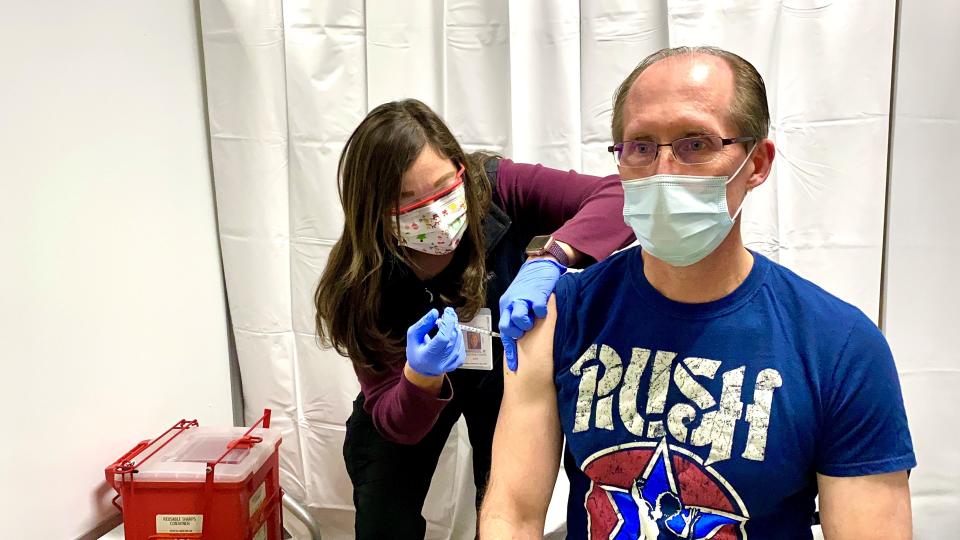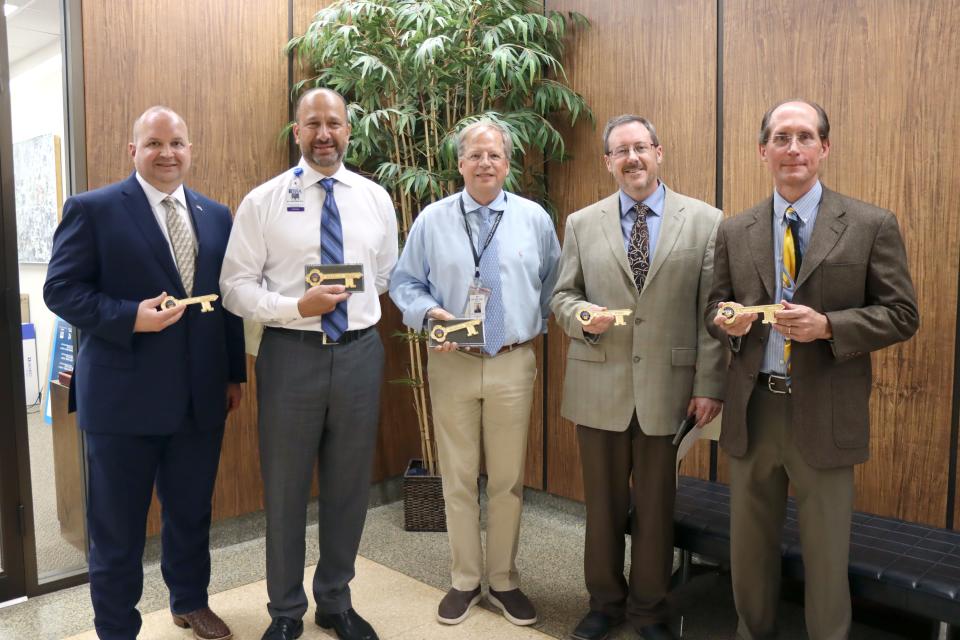Healthcare leaders address COVID-19 spike in Amarillo
Last week’s Amarillo COVID-19 report showed new cases doubling from the previous week, going from 286 new cases the previous week to 611 new cases in the latest report. With the rise in new cases among other metrics considered by the Centers for Disease Control and Prevention, it has raised the precaution level for Potter County to medium.
With this increase, the Amarillo Globe-News reached out to the healthcare leaders of the Northwest Texas Healthcare System and BSA Hospital to get their thoughts on the current rise in cases and what measures can be taken to reduce the impact of COVID-19 in the region.
More:Amarillo COVID-19 update shows 611 new cases, doubling last week's 7-day average
Dr. Brian Weis, chief medical officer for the Northwest Healthcare System, said that the trends are obvious about cases rising over the last three weeks in the area, and he has seen a rise in hospitalizations at his hospital. However, overall, even with the spike in cases, the severity has not been at previous levels that taxed his hospital staffs in the area.
“The good news is that thankfully most people are not getting very sick,” Weis said. “We do want people to be aware that we are seeing this trend upward. I do hope people will make the right choices for themselves about how they are to be protected. If that means that they want to start putting masks on to go into a busy store, then that is a great idea to help protect them.”
Weis said that he felt that rising numbers of positive COVID-19 cases may be underreported, due to many people now having access to at-home tests.
When asked about reports of new COVID-19 variants being very resistant to previous vaccinations, Weis stated that due to that issue, there is a great chance of a new booster being developed to help combat it, but he emphasized that there seems to still be a level of protection from people getting critically ill, versus without any vaccinations.
When asked about how to reduce the spread with the way things stand in the community, Weis stressed common-sense measures, such as being conscientious about hand hygiene and exposure to people. He said that if people feel sick, they should avoid crowded areas or going to work until they have been diagnosed.
Weis said there is a level of danger in being complacent, due to people returning to their everyday lives, in that people should take their health seriously if they feel ill and not take chances.
While he could see that many people feel like vaccines and boosters are not effective in preventing COVID-19, Weis says that vaccines have proven effective to reduce serious illness and hospitalization, and the numbers bear that out since their introduction.

Asked if people should be hesitant to put on a mask due to some in the public having backlash against them, Weis said that people should do what they need to protect themselves from getting sick, even if it makes them look like an outlier.
"There is no doubt that masks work,” Weis said. “We do know that these measures do help prevent the spread of these respiratory viruses.”
When asked if other issues such as the flu have gotten mixed in with COVID-19 making the numbers look worse, Weis emphatically denied that was the case.
“For a lot of our patients, we did not just evaluate for COVID-19. We did a full viral panel that simultaneously tests for over 20 viruses and bacteria that cause respiratory disease; if influenza was mixed in there, it would have been found in those tests,” Weis said. “We did not see influenza being mistaken for COVID-19 in these tests.”
Weis addressed the new immunizations for children younger than 5 years old and their effectiveness with the omicron variant.
“The big controversy among many is going to be these immunizations of young children. I have looked at the ligature, and I do not have any doubt about the safety of these immunizations,” Weis said. “These vaccines are not particularly good about preventing symptomatic infections from the omicron variants, but what they did show is that the vast majority of these children did not get very sick.”
He said that data shows repeatedly that these vaccines are safe for children. Weis also said that people who may be waiting on new boosters before getting one should still get vaccinated now if they have not previously been vaccinated, because it would still give them some level of protection.
When asked if there could be a new booster every year much like there is with influenza, Weis said that is very possible, but with much of the new research coming out, the variants could be targeted much more directly than the flu.
Dr. Michael Lamanteer, chief medical officer of BSA Hospital, also weighed in on the current surge in the region.
“There are certainly a number of individuals that do not have immunity, either by not having been vaccinated or previously infected (and) are still at higher risks for infection,” Lamanteer said.
He said that people who have had the primary series vaccination but have not gotten boosters are in a higher risk category than those who have gotten boosted and are getting infected.
Those things diminish the ability to have that immunization fight off the infections, Lamanteer said. “People over 50 and are immune-comprised should be getting these vaccinations and boosters."
When asked why infections seem to be higher than this period last year, Lamanteer said that while that is true, the bright aspect of the issue is that they are seeing way fewer hospitalizations.
“Transmission rates are high everywhere, but when it comes to COVID-19 hospitalization rates, our rates are fairly low and nothing like they were previously when we had this rate of positives,” Lamanteer said. “More people are getting infected, but its translating to less hospitalization and of the people coming to the hospital less who are requiring intensive care services.”
He said that of the 19 COVID-19 patients currently in the hospital as of Wednesday, only one required going to the intensive care unit. Previously, the hospital was seeing greater numbers of patients, with almost half requiring intensive care, according to Lamaneteer.
He said the factors affecting the amount of current hospitalizations were some levels of immunity from infections and vaccinations and omicron not being as deadly on the population as previous COVID-19 variants. He said people who at the highest risk now are those who have never contracted the virus or received immunization.
Lamanteer pushed back against those who just look at COVID-19 as the flu.

“We should not assume that COVID-19 has the same kind of seasonality as other respiratory infections such as the flu,”Lamanteer said. “The risk is present, regardless of the time of year, with COVID-19.”
Addressing boosters and the possibility of needing one every year, Lamanteer stated that with the nature of mortality seen with this virus, that is something that could be in the conversation for the next several years. He said that much of that depends on the amount of spread and the severity of the virus.
“The data and evidence support that vaccination prevents and reduces more severe disease, based on data,” Lamanteer said. “It is very much like how a flu shot affords better protection even to those that end up getting the flu. It is not there to prevent infection; it's to prevent severe after effects.”
He said that he was encouraged by the development of vaccines for younger children. With this, Lamanteer said that the benefits outweigh the risks of vaccinating children, and adverse reactions are much less likely than a severe reaction to COVID-19 infection. He said with the school year about to start, this could have a positive effect to reduce infections.
Addressing masking concerns, Lamanteer said that the highest risk individuals should definitely wear a mask, but overall, he said that he felt that others should be fine, not masking unless they are showing symptoms or have health concerns.
When asked about why the case rate has gone up in the area, Lamaneteer could not point to any particular reason for the surge, but he again urged against complacency about taking care of one’s health and stressed the need to be vaccinated.
“Folks need to be thoughtful about the symptoms they may be experiencing and take the proper precautions to keep them and others safe,” Lamanteer said. "People also need to be respectful to others that wear masks, because they could have very good reasons for wearing them.”
Currently, according to the Amarillo COVID-19 dashboard online, there are 1,619 active cases, which is up from last week's report by 269 cases, with three new deaths reported as of Thursday.

Vaccinations are available Monday through Friday at the Amarillo Public Health Department, located at 850 Martin Road, as well as mobile vaccinations via the mobile clinic, set up in various locations throughout the month. For a full schedule, and more information, visit amarilloalerts.com.
This article originally appeared on Amarillo Globe-News: Healthcare leaders address COVID-19 cases surging in Amarillo

